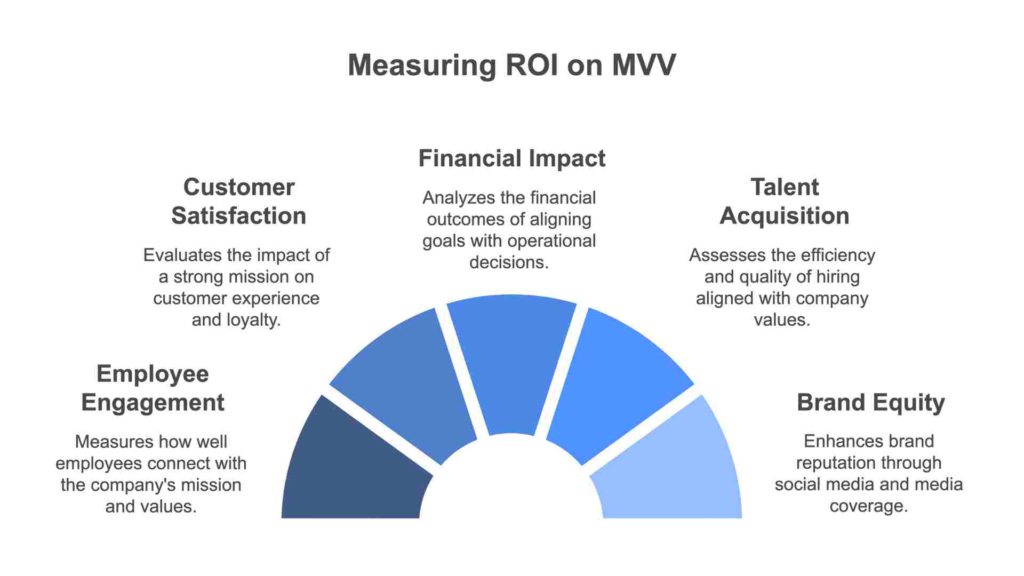Posted in Blog, Innovation, Lead Your Team, Strategy by Jo North
The ROI of a Strong Mission, Vision, and Values
Your company’s Mission, Vision and Values – MVV – can drive growth, shape decisions, and strengthen competitive edge. Investing in implementing a strong mission statement, a clear vision, and well-defined values delivers measurable results and generates positive ROI (Return on Investment).
Please remember, though, that whilst having an up-to-date MVV is a great start, on their own they are meaningless. You will only achieve strong ROI from them if you proactively use them to influence the culture, reputation, and decision-making in your company. All methods of measuring ROI on your MVV indicate how successfully you are implementing them in practice. i.e. how well you are living them, versus merely espousing them.
The Foundation: Mission, Vision, and Values
Mission defines the core purpose of the organization. A great mission statement articulates why the company exists and the value it delivers.
Vision provides a clear picture of the company’s long-term goals. A well-written vision statement acts as the North Star, guiding strategy execution and inspiring team members.
Values define the principles driving behavior across the company. Company values ensure alignment, supporting a strong company culture.
Clear mission and vision statements, along with lived values, enhance strategic alignment and organizational performance.
If you’d like to update your organization’s MVV, take a look at my detailed guide here. There’s also a step-by-step guide on how to facilitate a Mission, Vision and Values workshop with your team here.

The ROI of Clarity and Alignment
Employee Engagement and Retention
Studies show a clear mission reduces turnover and improves employee retention. Team members who understand the company’s mission statement and embrace its values show higher levels of employee engagement. Engaged employees deliver a better customer experience, generate innovative ideas, and contribute to long-term success. For example, a recognition program tied to a company’s core values ensures employees feel valued and aligned with the organization’s purpose.
Research from the London School of Economics found that higher employee engagement correlates with improved performance and reduced absenteeism.
Strategic Focus
A well-articulated vision aligns the entire organization towards a common goal. This creates a shared sense of purpose, which improves collaboration among internal stakeholders. In the long run, a strong vision enhances strategy execution and ensures a positive impact on the bottom line.
Case Study Example: Ikea
The IKEA Vision
IKEA’s vision is: “To create a better everyday life for the many people.”
Ikea states: “This vision goes beyond home furnishing. We want to have a positive impact on the world – from the communities where we source our raw materials to the way our products help our customers live a more sustainable life at home.
By sharing what we do, and speaking up for what we believe in, we can be part of positive change in society.”
The IKEA Business Idea, or Mission
Ingvar Kamprad, IKEA Founder said: While our vision tells us why we exist, our business idea tells us what we want to achieve. And if you’ve ever visited IKEA, you’ll have probably worked out what our business idea is – “to offer a wide range of well-designed, functional home furnishing products at prices so low that as many people as possible will be able to afford them.”
The IKEA Values
IKEA’s values reflect what they consider to be important. So important in fact that they refer to them as one of their “forever parts”. They say that their values guide them in their everyday lives at work, in everything from how they treat people and the planet to how they make decisions – large or small. Their values are:
- Togetherness
- Caring for people and the planet
- Cost-consciousness
- Simplicity
- Renew and improve
- Different with a meaning
- Give and take responsibility
- Lead by example
IKEA’s MVV and Strategy
IKEA’s mission, vision, and values have been instrumental in shaping its strategic direction. The company’s mission focuses on designing functional, attractive, and reliable home furnishings at affordable prices, catering to consumers’ everyday needs. This mission drives IKEA’s strategy of product development and cost leadership.
Sustainability forms a core part of IKEA’s vision and values. The company has committed to sourcing 100% of its cotton from sustainable sources, working with farmers to reduce water and pesticide use, supporting environmental sustainability and the livelihoods of over 110,000 farmers.
By aligning its mission, vision, and values with its strategic initiatives, IKEA has strengthened its competitive advantage, secured long-term access to essential raw materials, and developed positive relationships with suppliers and customers. This alignment has been fundamental to driving the company’s growth and success.

Organizational Culture
Companies with a positive, innovative company culture outperform competitors. Strong company culture helps to build trust and inspires hard work. It attracts top talent, ensuring the company remains competitive in hiring creative minds and strong candidates.
Case Study Example: Orica
Orica, a leading provider of explosives and chemicals to the mining and infrastructure sectors, has committed to reducing carbon emissions through a comprehensive decarbonization strategy.
The company focuses on lowering emissions at their factories and creating greener products, such as low-carbon ammonia and ammonium nitrate. Significant improvements have been achieved by implementing emissions-reducing technology at their nitric acid plants in Kooragang Island and Yarwun in Australia, developed by ThyssenKrupp.
This technology significantly reduces nitrous oxide, a potent greenhouse gas. Orica targets a 30% reduction in scope 1 and 2 emissions by 2026 and a 45% reduction by 2030, from their 2019 baseline. They also aspire to reduce scope 3 emissions by 25% by 2035. Also, Orica aims for 60% of its power to come from renewable electricity by 2030.
Key future steps include the decarbonization of ammonia production, contingent on successful green hydrogen projects. Orica emphasizes the need for collaboration among industries and with governments to tackle decarbonization challenges. They are engaged in joint ventures to transform captured carbon dioxide into building materials and expand high-purity aluminum production.
By aligning its mission, vision, and values with its strategic initiatives, Orica has strengthened its competitive advantage, secured long-term access to essential raw materials, and developed positive relationships with suppliers and customers.
Connecting Values to the Bigger Picture
Successful organizations keep their mission, vision and values relevant, and connect their values to their ultimate goal. For instance, Amazon’s mission to become “the earth’s most customer-centric company” ties its mission and values into every action, creating alignment across teams and ensuring the right thing gets done. They say:
“Our Leadership Principles (values) describe how Amazon does business, how leaders lead, and how we keep the customer at the center of our decisions. Our unique Amazon culture, described by our Leadership Principles, helps us relentlessly pursue our mission of being Earth’s most customer-centric company, best employer, and safest place to work.”
Interactive Resources for Better Engagement
Interactive resources, such as workshops and in-person events, can help to bring company values to life. Employees connect more deeply with the company’s purpose when they actively participate in defining and practicing values.
Storytelling as a Powerful Tool
Using the power of storytelling can help to make your mission, vision, and values memorable and bring them to life. Stories about meaningful work create emotional connections. They also reinforce the purpose of a mission statement by illustrating real-world impacts on people’s lives.
Value Statements that Resonate
Value statements should reflect the company’s unique identity. For example, Tesla’s focus on innovative technologies and sustainable energy reflects its brand values and positions it as an industry leader.

Measuring ROI on Mission, Vision, and Values
Again, as I’ve stated above, whilst having an up-to-date MVV is a great start, on their own they are meaningless. You will only achieve strong ROI from them if you proactively use them to influence the culture, reputation, and decision-making in your company. All methods of measuring ROI on your MVV are in fact demonstrating how successfully (or not) you are implementing them in practice. i.e. how well you are living them, versus merely espousing them.
Typical Methods for Measuring ROI on Mission, Vision, and Values (MVV)
Here are some typical methods for measuring ROI on your MVV:
- Employee engagement surveys: Regularly measure how well team members connect with the company’s mission and values. Improved engagement often correlates with increased productivity and lower turnover.
- Customer satisfaction metrics: Track how a strong mission influences customer experience. A mission-driven company often achieves higher Net Promoter Scores (NPS) and customer loyalty. You can also track external stakeholder engagement and satisfaction through surveys and ongoing dialogue.
- Revenue growth analysis: Evaluate the financial impact of aligning long-term goals with operational decisions.
- Retention rates: Use retention metrics to quantify the impact of a strong organizational culture. High retention reduces recruitment costs and improves overall team cohesion.

Additional Metrics for Measuring ROI on Mission, Vision, and Values (MVV)
While common metrics such as employee engagement surveys and customer satisfaction scores are valuable, there are less obvious methods that can provide deeper insights into the ROI of your MVV implementation:
Talent Acquisition Efficiency
A strong MVV attracts top talent. Measure:
- Time-to-hire: Track how quickly you can fill roles. A compelling MVV often reduces this timeframe.
- Quality of hire: Use performance reviews and manager feedback to assess the alignment of new hires with company values.
- Cost per hire: Analyze whether a strong MVV reduces recruitment costs, as engaged employees often act as brand ambassadors.
Operational Alignment Metrics
Strong MVV statements should drive consistency in decision-making. Monitor:
- Strategic initiative success rates: Track the completion rates and outcomes of major projects to assess alignment with the company’s mission and vision.
- Cross-department collaboration: Use internal surveys to evaluate how effectively teams collaborate on mission-driven goals. Improved alignment reduces silos and boosts efficiency.
Brand Equity Growth
A strong MVV can enhance brand reputation. Measure:
- Social media sentiment: Monitor brand mentions and sentiment analysis to gauge how your MVV resonates with the public.
- Earned media value: Track press coverage and public recognition tied to your MVV-driven initiatives.
Innovation Metrics
Values that encourage creativity and risk-taking can lead to successful innovation. Assess:
- Number of new ideas implemented: Track the volume of ideas adopted from employee suggestions or innovation programs.
- Revenue from new products or services: Measure the financial contribution of innovations aligned with your vision.
ESG (Environmental, Social, and Governance) Impact
Values focused on sustainability or community support strengthen your competitive edge. Evaluate:
- Carbon footprint reduction: Measure progress against environmental goals.
- Community engagement: Track metrics like volunteer hours, donations, or partnerships aligned with your values.
Resilience During Crises
Strong MVVs support unity and adaptability. Analyze:
- Crisis response times: Measure how quickly your organization adapts during disruptions.
- Retention during downturns: Compare turnover rates during challenging periods to gauge cultural strength.
Leadership Alignment
Leadership sets the tone for living the MVV. Use:
- Values-driven decision audits: Review key decisions for alignment with stated values.
- Leadership effectiveness surveys: Include questions that evaluate how well leaders embody and communicate the mission and vision.
Long-Term Financial Metrics
MVV can drive sustainable growth, which can be measured through:
- Customer Lifetime Value (CLV): Higher CLV often reflects strong mission-driven relationships.
- Market share growth: Monitor whether a clear vision helps outpace competitors in capturing market share.
Implementing These Metrics
- Regular reviews: Integrate these measurements into quarterly business reviews.
- Technology tools: Use software solutions to track and analyze these metrics in real-time.
- Transparency: Share progress with stakeholders to build trust and accountability.
By expanding your measurement framework, you can assess the true impact of your implementation of MVV on organizational performance, and help continuous improvement.
The Long Run Benefits
Companies that integrate mission, vision, and values into their daily operations experience compounding benefits. Over time, these elements shape a culture of accountability, attract investors, and deliver sustainable business success.

Best Practices for Success
- Leadership buy-In: Ensure leaders embody the company’s mission and values. Their actions set the tone for the entire organization.
- Training programs: Offer training on how to integrate values into daily work. Interactive resources like workshops can reinforce alignment.
- Recognition programs: Reward team members who exemplify company values. Highlighting these behaviors reinforces the importance of cultural alignment.
- Identify specific actions that bring your company’s values to life.
Summary
Investing in a company’s mission, vision, and values delivers returns across the board. When used proactively as a North Star, they help to create a positive culture, align team members, and shape a sense of unity. They can be powerful tool to attract top talent, inspire innovation, and achieve sustainable growth. By following clear steps and measuring outcomes, you can maximize the ROI of your organization’s mission, vision, and values. If you’d like any support with your company’s mission, vision, and values, please do get in touch here. I’d love to hear from you. And if you’d like to see our MVV, you’ll find them here.


